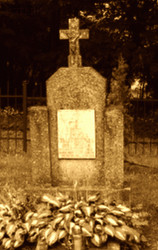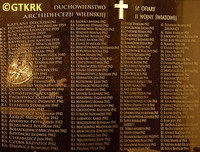Roman Catholic
St Sigismund parish
05-507 Słomczyn
85 Wiślana Str.
Konstancin deanery
Warsaw archdiocese, Poland
full list:
displayClick to display full list

searchClick to search full list by categories
wyświetlKliknij by wyświetlić pełną listę po polsku

szukajKliknij by przeszukać listę wg kategorii po polsku

Martyrology of the clergy — Poland
XX century (1914 – 1989)
personal data

surname
TUTINAS
forename(s)
John (pl. Jan)
function
diocesan priest
creed
Latin (Roman Catholic) Church RCmore on
en.wikipedia.org
[access: 2014.09.21]
diocese / province
Kaišiadory diocesemore on
en.wikipedia.org
[access: 2017.06.16]
Vilnius archdiocesemore on
en.wikipedia.org
[access: 2013.05.19]
nationality
Lithuanian
date and place
of death
24.06.1941

Palomenėtoday: Palomenė eld., Kaišiadorys dist., Kaunas Cou., Lithuania
more on
lt.wikipedia.org
[access: 2020.07.31]
details of death
During World War I soldier of the Russian army on Turkish front (Trebizond/Trabzon).
In 1937 deported — by Mr Louis Bociański, Vilnius Voivode, prob. freemason, supporter of a forced polonization of the Vilnius region — from Poland to Lithuania for anti–Polish and pro–Lithuanian stance.
Wished to come back to Vilnius diocese but was prevented from.
After German and Russian invasion of Poland in 09.1939 and start of the World War II, after German attack on 22.06.1941 of their erstwhile ally, Russians, murdered — tortured, pierced with bayonets — by escaping in panic Russian soldiers, together with a number of his church collaborators, including organist's wife.
cause of death
mass murder
perpetrators
Russians
sites and events
06.1941 massacres (NKVD)Click to display the description, Ribbentrop‐MolotovClick to display the description, Pius XI's encyclicalsClick to display the description
date and place
of birth
23.08.1897

Šakiaitoday: Suginčiai eld., Molėtai dist., Utena Cou., Lithuania
more on
lt.wikipedia.org
[access: 2020.07.31]
alt. dates and places
of birth
1894
presbyter (holy orders)
ordination
28.03.1928

positions held
1939 – 1941
administrator — Palomenėtoday: Palomenė eld., Kaišiadorys dist., Kaunas Cou., Lithuania
more on
lt.wikipedia.org
[access: 2020.07.31] ⋄ RC parish ⋄ Kaišiadorystoday: Kaišiadorys urban eld., Kaišiadorys dist., Kaunas Cou., Lithuania
more on
en.wikipedia.org
[access: 2022.01.06] RC deanery
1937 – 1939
vicar — Palomenėtoday: Palomenė eld., Kaišiadorys dist., Kaunas Cou., Lithuania
more on
lt.wikipedia.org
[access: 2020.07.31] ⋄ RC parish ⋄ Kaišiadorystoday: Kaišiadorys urban eld., Kaišiadorys dist., Kaunas Cou., Lithuania
more on
en.wikipedia.org
[access: 2022.01.06] RC deanery
1931 – 1937
parish priest — Pelesatoday: Boltishki ssov., Voranava dist., Grodno reg., Belarus
more on
be.wikipedia.org
[access: 2023.01.18] ⋄ St Linus the Pope and Martyr RC parish ⋄ Raduntoday: Radun ssov., Voranava dist., Grodno reg., Belarus
more on
en.wikipedia.org
[access: 2022.01.06] RC deanery
1929 – 1931
vicar — Eišiškėstoday: Eišiškės eld., Šalčininkai dist., Vilnius Cou., Lithuania
more on
en.wikipedia.org
[access: 2020.12.11] ⋄ Ascension of the Lord RC parish ⋄ Raduntoday: Radun ssov., Voranava dist., Grodno reg., Belarus
more on
en.wikipedia.org
[access: 2022.01.06] RC deanery
1928 – 1929
vicar — Dzyatlavatoday: Dzyatlava dist., Grodno reg., Belarus
more on
en.wikipedia.org
[access: 2022.01.06] ⋄ Assumption of the Blessed Virgin Mary RC parish ⋄ Dzyatlavatoday: Dzyatlava dist., Grodno reg., Belarus
more on
en.wikipedia.org
[access: 2022.01.06] RC deanery
1923 – 1928
student — Vilniustoday: Vilnius city dist., Vilnius Cou., Lithuania
more on
en.wikipedia.org
[access: 2022.01.06] ⋄ philosophy and theology, Theological Seminary
others related
in death
MAZURKIEWICZClick to display biography Vincent, STANKIEWICZClick to display biography Sigismund, VĖGĖLĖClick to display biography Boleslav Balys, WITKIEWICZClick to display biography Francis, BALČIUSClick to display biography Valentine, BALSYSClick to display biography Vaclav, BALTRIMASClick to display biography Stanislav Edward, DABRILAClick to display biography Justin, DAMBRAUSKASClick to display biography Vaclav, DAUGĖLAClick to display biography John, JUKNEVIČIUSClick to display biography Andrew, LAJAUSKASClick to display biography Matthew, NAVICKASClick to display biography John, PAULAVIČIUSClick to display biography Constantine, PETRIKAClick to display biography John, RACEVIČIUSClick to display biography Paul, STULGINSKISClick to display biography Vaclav, ŠVEIKAUSKASClick to display biography Benedykt, VANAGASClick to display biography Benedykt
sites and events
descriptions
06.1941 massacres (NKVD): After German attack of Russian‐occupied Polish territory and following that of Russia itself, before a panic escape, Russians murdered — in accordance with the genocidal order issued on 24.06.1941 by the Russian interior minister Lawrence Beria to murder all prisoners (formally „sentenced” for „counter‐revolutionary activities”, „anti‐Russian acts”, sabotage and diversion, and political prisoners „in custody”), held in NKVD‐run prisons in Russian occupied Poland, Lithuania, Latvia and Estonia — c. 40,000‐50,000 prisoners. In addition Russians murdered many thousands of victims arrested after German attack regarding them as „enemies of people” — those victims were not even entered into prisons’ registers. Most of them were murdered in massacres in the prisons themselves, the others during so‐called „death marches” when the prisoners were driven out east. After Russians departure and start of German occupation a number of spontaneous pogroms of Jews took place. Many Jews collaborated with Russians and were regarded as co‐responsible for prison massacres. (more on: en.wikipedia.orgClick to attempt to display webpage
[access: 2021.12.19])
Ribbentrop‐Molotov: Genocidal Russian‐German alliance pact between Russian leader Joseph Stalin and German leader Adolf Hitler signed on 23.08.1939 in Moscow by respective foreign ministers, Mr. Vyacheslav Molotov for Russia and Joachim von Ribbentrop for Germany. The pact sanctioned and was the direct cause of joint Russian and German invasion of Poland and the outbreak of the World War II in 09.1939. In a political sense, the pact was an attempt to restore the status quo ante before 1914, with one exception, namely the „commercial” exchange of the so‐called „Kingdom of Poland”, which in 1914 was part of the Russian Empire, fore Eastern Galicia (today's western Ukraine), in 1914 belonging to the Austro‐Hungarian Empire. Galicia, including Lviv, was to be taken over by the Russians, the „Kingdom of Poland” — under the name of the General Governorate — Germany. The resultant „war was one of the greatest calamities and dramas of humanity in history, for two atheistic and anti‐Christian ideologies — national and international socialism — rejected God and His fifth Decalogue commandment: Thou shall not kill!” (Abp Stanislav Gądecki, 01.09.2019). The decisions taken — backed up by the betrayal of the formal allies of Poland, France and Germany, which on 12.09.1939, at a joint conference in Abbeville, decided not to provide aid to attacked Poland and not to take military action against Germany (a clear breach of treaty obligations with Poland) — were on 28.09.1939 slightly altered and made more precise when a treaty on „German‐Russian boundaries and friendship” was agreed by the same murderous signatories. One of its findings was establishment of spheres of influence in Central and Eastern Europe and in consequence IV partition of Poland. In one of its secret annexes agreed, that: „the Signatories will not tolerate on its respective territories any Polish propaganda that affects the territory of the other Side. On their respective territories they will suppress all such propaganda and inform each other of the measures taken to accomplish it”. The agreements resulted in a series of meeting between two genocidal organization representing both sides — German Gestapo and Russian NKVD when coordination of efforts to exterminate Polish intelligentsia and Polish leading classes (in Germany called «Intelligenzaktion», in Russia took the form of Katyń massacres) where discussed. Resulted in deaths of hundreds of thousands of Polish intelligentsia, including thousands of priests presented here, and tens of millions of ordinary people,. The results of this Russian‐German pact lasted till 1989 and are still in evidence even today. (more on: en.wikipedia.orgClick to attempt to display webpage
[access: 2015.09.30])
Pius XI's encyclicals: Facing the creation of two totalitarian systems in Europe, which seemed to compete with each other, though there were more similarities than contradictions between them, Pope Pius XI issued in 03.1937 (within 5 days) two encyclicals. In the „Mit brennender Sorge” (Eng. „With Burning Concern”) published on 14.03.1938, condemned the national socialism prevailing in Germany. The Pope wrote: „Whoever, following the old Germanic‐pre‐Christian beliefs, puts various impersonal fate in the place of a personal God, denies the wisdom of God and Providence […], whoever exalts earthly values: race or nation, or state, or state system, representatives of state power or other fundamental values of human society, […] and makes them the highest standard of all values, including religious ones, and idolizes them, this one […] is far from true faith in God and from a worldview corresponding to such faith”. On 19.03.1937, published „Divini Redemptoris” (Eng. „Divine Redeemer”), in which criticized Russian communism, dialectical materialism and the class struggle theory. The Pope wrote: „Communism deprives man of freedom, and therefore the spiritual basis of all life norms. It deprives the human person of all his dignity and any moral support with which he could resist the onslaught of blind passions […] This is the new gospel that Bolshevik and godless communism preaches as a message of salvation and redemption of humanity”… Pius XI demanded that the established human law be subjected to the natural law of God , recommended the implementation of the ideal of a Christian state and society, and called on Catholics to resist. Two years later, National Socialist Germany and Communist Russia came together and started World War II. (more on: www.vatican.vaClick to attempt to display webpage
[access: 2023.05.28], www.vatican.vaClick to attempt to display webpage
[access: 2023.05.28])
sources
personal:
www.kaisiadoriumuziejus.ltClick to attempt to display webpage
[access: 2015.05.09], angelorum.ltClick to attempt to display webpage
[access: 2015.05.09], lt.wikipedia.orgClick to attempt to display webpage
[access: 2020.07.31]
bibliographical:
„Martyrology of the Polish Roman Catholic clergy under nazi occupation in 1939‐1945”, Victor Jacewicz, John Woś, vol. I‐V, Warsaw Theological Academy, 1977‐1981
„Vilnius archdiocese clergy martyrology 1939‐1945”, Fr Thaddeus Krahel, Białystok, 2017
original images:
angelorum.ltClick to attempt to display webpage
[access: 2015.05.09], ipn.gov.plClick to attempt to display webpage
[access: 2019.02.02], www.ciekawepodlasie.plClick to attempt to display webpage
[access: 2020.07.31]
LETTER to CUSTODIAN/ADMINISTRATOR
If you have an Email client on your communicator/computer — such as Mozilla Thunderbird, Windows Mail or Microsoft Outlook, described at WikipediaPatrz:
en.wikipedia.org, among others — try the link below, please:
LETTER to CUSTODIAN/ADMINISTRATORClick and try to call your own Email client
If however you do not run such a client or the above link is not active please send an email to the Custodian/Administrator using your account — in your customary email/correspondence engine — at the following address:

giving the following as the subject:
MARTYROLOGY: TUTINAS John
To return to the biography press below:
 Click to return to biography
Click to return to biography










